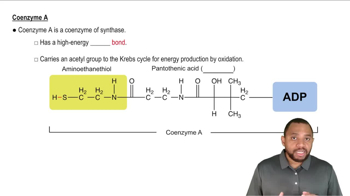The reaction that follows is catalyzed by isocitrate dehydrogenase and occurs in two steps, the first of which (step A) is formation of an unstable intermediates (shown in brackets).
a. In which step is a coenzyme needed? Identify the coenzyme.
 Verified step by step guidance
Verified step by step guidance Verified video answer for a similar problem:
Verified video answer for a similar problem:



 2:2m
2:2mMaster Coenzymes in Metabolism Concept 1 with a bite sized video explanation from Jules
Start learning